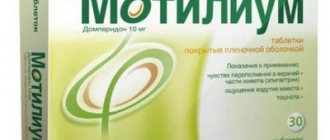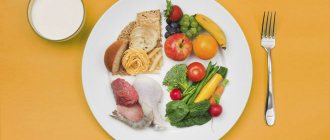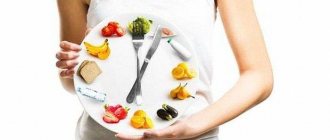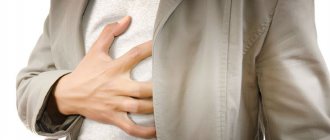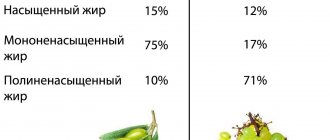The text is for informational purposes only. We strongly urge you not to use diets, resort to any therapeutic menus or fasting without medical supervision. We recommend reading: “Why can’t you go on a diet on your own?”
Proper nutrition is of great importance for the prevention and treatment of stomach inflammation. The diet reduces the severity of painful manifestations and increases the effectiveness of therapeutic manipulations.
An imbalance of food components (proteins, fats, carbohydrates, fiber) changes the pH of the stomach, stimulates the pathogenesis of gastritis, including gastric ulcers. All diets for chronic stomach diseases are developed taking into account the acidity of the gastric environment.
Based on nutritional value, treatment tables for gastritis are divided into two types:
- Basic diets. The diet contains a sufficient amount of energy necessary to maintain the patient’s vital functions, and at the same time has a beneficial effect on the walls of the stomach;
- Low-calorie diets. In case of exacerbation of pathogenesis (acute digestive disorders - constipation, diarrhea), a diet with reduced energy value is used for several days.
Diets (tables) used to feed patients with gastritis have digital designations. Official medicine has approved fifteen basic numbered therapeutic diets. Some tables come in several variations, designated by letters of the alphabet. For stomach diseases, tables 1a, 1b, , and are recommended. During the period of therapeutic nutrition for gastritis, you should give up alcohol and smoking, as well as fatty, smoked, pickled, spicy and sour foods.
The nutrition of patients diagnosed with gastritis is based on several principles underlying such diets:
- Exclude hot (above 600C) and cold (below 150C) dishes from the diet;
- Choose the optimal temperature for dietary food (20-500C);
- Use the rules of eating: small portions (up to 5-6 times a day) and regularity (at the same time);
- For hyperacid gastritis, exclude from the diet foods that stimulate the production of hydrochloric acid and irritate the walls of the stomach;
- For hypoacid and anacid gastritis, give preference to foods that speed up digestion;
- If a person has two diseases at the same time, for example, gastritis and diabetes, foods that are harmful for diabetes should also be excluded from the diet.
What can you eat if you have gastritis with high acidity?
The diagnosis of “chronic gastritis with high acidity” or “chronic hyperacid gastritis” is confirmed by comprehensive medical studies using laboratory and functional diagnostic methods.
The disease is characterized by an increase in the amount of hydrochloric acid, digestive enzymes and other components of gastric juice produced. Acid irritates the walls of the stomach, reduces their functional properties and changes the course of the physiological processes of digestion.
The main symptoms of gastritis with high acidity are pain between meals, heartburn after eating.
For gastritis with high acidity, it is prohibited to consume dishes based on rich mushroom, meat and fish broths, as well as instant semi-finished products. They strongly irritate the taste buds and stimulate additional production of hydrochloric acid.
The set of dishes that should comprise the diet of a patient diagnosed with gastritis with high acidity includes:
- First courses (puree soups with vegetables and cereals, noodle soups cooked with water or milk);
- Main courses (meat, fish, chopped into pieces, steamed, boiled or baked, sometimes lightly fried, without crust);
- Side dishes (boiled vegetables, pasta, soft cereals);
- Salads, snacks (boiled vegetable salads, snacks based on lean meats, fish, dairy sausages, cheese);
- Milk 2.5% pasteurized, some fermented milk products (cream, yogurt, cottage cheese);
- Fruits and berries of sweet varieties;
- Drinks (tea, dried fruit compotes, jelly, juices from some types of fruits, decoctions);
- Bakery products (dried wheat bread, dry biscuits);
- Fats (vegetable oils, butter).
More details about each ingredient in the menu for a patient with hyperacid gastritis:
- Beef. It is recommended to use meat of the first category with limited fat content. The energy value of this product is about 218 kcal per 100 g. The ratio of proteins and fats is 1:1. Beef contains a lot of macro- and microelements, especially phosphorus, sulfur, iron, zinc, copper, chromium, cobalt and molybdenum, as well as a high content of B vitamins. Chopped steam cutlets, portioned pieces of boiled, stewed, baked meat are prepared from beef;
- Mutton. Lean meat is allowed, its energy value per 100 g is about 209 kcal, the ratio of proteins and fats is 1:1. The product contains a lot of macroelements - potassium, sulfur, phosphorus, microelements - copper, fluorine. Due to its specific taste and smell, lamb is rarely used in medical institutions, but it is quite possible to cook it at home;
- Rabbit meat - energy value 100 g - about 183 kcal. The ratio of proteins and fats is 2:1. Meat contains enough macro- and microelements and vitamins. Lean rabbit meat is considered one of the best meat products for hyperacid gastritis. Boiled, stewed, baked pieces are prepared;
- Chicken meat. Energy value of 100 g is 90-180 kcal, depending on the part of the carcass. The ratio of proteins and fats approximately corresponds to those of rabbit meat. The most valuable is white skinless chicken breast meat. Prepare boiled and baked pieces;
- Sausages. Eat as a snack. It is recommended to consume up to 50 g per day of lean varieties of boiled milk and doctor's sausage. Sausages can be replaced with offal snacks - pates;
- Beef tongue. Its energy value is about 173 kcal per 100 g. It is a tasty by-product of the first category. It is nutritious and rich in nutrients. Used boiled, as a warm snack;
- Sausages. The use of this product is not regulated by the official diet for gastritis. Since it is possible to use low-fat varieties of milk sausages, it should be assumed that milk sausages can also be eaten with gastritis with high acidity. It is not recommended to choose smoked and fried sausages, sausages and bacon with a large amount of pork fat;
- Sea fish. Low-fat varieties are recommended. The usual amount of fat in fish is up to 15-20%. Fish with low fat content are marine species (cod, tuna). The fat content in them is from 0.4 to 0.8%, and the protein content is from 17.6% (cod) to 22.8% (tuna). The energy value of this fish ranges from 148 kcal per 100 (cod) to 297 kcal per 100 g (tuna). Fish contains healthy unsaturated fats (omega-3, omega-6). Low-fat herring soaked in water (milk) is allowed as a snack. For hyperacid gastritis, small quantities of sturgeon caviar are allowed;
- River fish. Low fat content in pike perch and pike. The limited consumption of river fish in medical institutions is due to the large number of small bones. At home, boiled pieces and steamed fish cutlets are prepared;
- Milk. Usually pasteurized cow's milk with 2.5% fat content is used. Whole milk (straight from the cow) is prohibited in the diet. The energy value of 2.5% milk is 54 kcal per 100 ml. Pasteurized milk can be consumed without additional heat treatment. Warm dishes are prepared on it: soups, porridges, purees, omelettes. Individual intolerance to milk components is possible;
- Cream is milk that has been separated to 10% (normal cream) or 35% (heavy cream). Heavy cream is not used in diets, but normal cream is added in small quantities to main dishes, sauces and puddings;
- Hard cheeses - Parmesan, Dutch, Kostroma, Cheddar and others. Energy value is about 355 kcal per 100 g of product. Used as snacks. For gastritis with high acidity, hard cheeses with limited fat content (30-50%) without spicy additives are recommended. You can consume more than 20-50 grams of cheese per day;
- Soft cheeses - Mascarpone and others. The calorie content of Mascarpone cheese is 450 kcal per 100 g of product. For dietary nutrition, you need to choose mild, unsalted varieties of cheese. A moderate amount of cheese can significantly adjust the balance of proteins and fats of animal origin, as well as microelements in the daily diet of a patient with gastritis;
- Cottage cheese. Non-acidic varieties are recommended. The percentage of fat content is from 0% (low-fat cottage cheese) to 30% (fat cottage cheese). The energy and nutritional value of such a product is very high. Cottage cheese can be used as curds, cheesecakes, fried without crust;
- Yogurt. Standard fat content is 3.2%. The product is low in calories - only 65 kcal per 100 g. Yogurt contains enough sugar and few acids. The main varieties of yoghurt are suitable for dietary nutrition for gastritis;
- Chicken eggs. The energy value is 157 kcal per 100 g of product. The ratio of proteins and fats is approximately 1:1. For gastritis, use fresh eggs produced (obtained from a chicken) no later than seven days ago. Soft-boiled eggs and omelettes with milk or cream are recommended. Raw eggs are prohibited in dietary foods due to poor digestibility of raw proteins;
- Porridge. The calorie content of porridge exceeds the energy value of meat products. However, plant carbohydrates provide quick energy. Porridge should not be considered the main component of dietary nutrition for gastritis. Popular cereals are used to prepare porridges, slimy soups, puddings and other dishes: semolina, rice, buckwheat, and oatmeal.
Semolina – energy value 100 g – 335 kcal. The main amount of energy comes from carbohydrates. Despite the high content of macro- and microelements and vitamins, semolina is carefully used in the dietary nutrition of children under 3 years of age and elderly people over 70 years of age. A high level of individual intolerance to the product was observed in these age groups;
- Rice cereal - energy value 100 g - 323 kcal. A 100-gram portion provides approximately 20% of a person’s daily energy requirement. Rice contains many useful substances. It contains components that relieve irritation of the stomach walls and has antioxidant properties;
- Buckwheat – energy value 100 g – 335 kcal. Valuable dietary product. Regulates blood cholesterol levels, normalizes metabolic processes, promotes weight loss;
- Oatmeal – energy value 100 g – 342 kcal. Oatmeal is allowed. Porridges made from oatmeal (flakes) have a high energy value and contain the maximum range of macro- and microelements and B vitamins. The mucous substances of oatmeal reduce irritation of the stomach walls.
Beet or cane sugar, jam, jams from strawberries and sweet apples are used to a limited extent as sweeteners.
Fully or partially limited products
- Vegetables are excluded: radish, radishes, turnips, white cabbage, beans, peas, rutabaga, sorrel, onions, as they are coarse and irritating to the gastrointestinal mucosa. Tomatoes can cause increased pain. Mushrooms are prohibited, as they are a difficult-to-digest product, as well as fruits with peels.
- Foods with connective tissue (skin, cartilage, veins) that are difficult to digest.
- Cabbage soup, highly extractive broths, okroshka and borscht are excluded from the first courses.
- Fatty fish, fatty pork, goose, canned and smoked meats, duck, lamb, canned fish.
- Millet, barley, pearl barley and corn cereals, coarse pasta.
- Pickled, salted and pickled vegetables, canned vegetables - all these products cause increased secretion.
- Fried eggs and hard-boiled eggs are difficult to digest foods.
- Meat and tomato sauce, horseradish, mustard, pepper, as products that irritate the mucous membranes.
- Animals, cooking fats, margarine.
- Fresh bread, rye, butter and puff pastry.
- Fermented milk products are highly acidic, as they stimulate gastric secretion.
- Sour fruits and berries, chocolate, ice cream.
Table of prohibited products
| Proteins, g | Fats, g | Carbohydrates, g | Calories, kcal | |
Vegetables and greens | ||||
| vegetables legumes | 9,1 | 1,6 | 27,0 | 168 |
| swede | 1,2 | 0,1 | 7,7 | 37 |
| cabbage | 1,8 | 0,1 | 4,7 | 27 |
| sauerkraut | 1,8 | 0,1 | 4,4 | 19 |
| green onion | 1,3 | 0,0 | 4,6 | 19 |
| bulb onions | 1,4 | 0,0 | 10,4 | 41 |
| cucumbers | 0,8 | 0,1 | 2,8 | 15 |
| canned cucumbers | 2,8 | 0,0 | 1,3 | 16 |
| white radish | 1,4 | 0,0 | 4,1 | 21 |
| turnip | 1,5 | 0,1 | 6,2 | 30 |
| canned tomatoes | 1,1 | 0,1 | 3,5 | 20 |
| horseradish | 3,2 | 0,4 | 10,5 | 56 |
| spinach | 2,9 | 0,3 | 2,0 | 22 |
| sorrel | 1,5 | 0,3 | 2,9 | 19 |
Mushrooms | ||||
| mushrooms | 3,5 | 2,0 | 2,5 | 30 |
Cereals and porridges | ||||
| corn grits | 8,3 | 1,2 | 75,0 | 337 |
| pearl barley | 9,3 | 1,1 | 73,7 | 320 |
| millet cereal | 11,5 | 3,3 | 69,3 | 348 |
| barley grits | 10,4 | 1,3 | 66,3 | 324 |
Confectionery | ||||
| candies | 4,3 | 19,8 | 67,5 | 453 |
Ice cream | ||||
| ice cream | 3,7 | 6,9 | 22,1 | 189 |
Cakes | ||||
| cake | 4,4 | 23,4 | 45,2 | 407 |
Raw materials and seasonings | ||||
| mustard | 5,7 | 6,4 | 22,0 | 162 |
| ginger | 1,8 | 0,8 | 15,8 | 80 |
| ketchup | 1,8 | 1,0 | 22,2 | 93 |
| mayonnaise | 2,4 | 67,0 | 3,9 | 627 |
| ground black pepper | 10,4 | 3,3 | 38,7 | 251 |
| chilli | 2,0 | 0,2 | 9,5 | 40 |
Meat products | ||||
| pork | 16,0 | 21,6 | 0,0 | 259 |
| ham | 22,6 | 20,9 | 0,0 | 279 |
Sausages | ||||
| dry-cured sausage | 24,1 | 38,3 | 1,0 | 455 |
| sausages | 10,1 | 31,6 | 1,9 | 332 |
| sausages | 12,3 | 25,3 | 0,0 | 277 |
Bird | ||||
| smoked chicken | 27,5 | 8,2 | 0,0 | 184 |
| duck | 16,5 | 61,2 | 0,0 | 346 |
| smoked duck | 19,0 | 28,4 | 0,0 | 337 |
| goose | 16,1 | 33,3 | 0,0 | 364 |
Fish and seafood | ||||
| dried fish | 17,5 | 4,6 | 0,0 | 139 |
| smoked fish | 26,8 | 9,9 | 0,0 | 196 |
| canned fish | 17,5 | 2,0 | 0,0 | 88 |
Oils and fats | ||||
| animal fat | 0,0 | 99,7 | 0,0 | 897 |
| cooking fat | 0,0 | 99,7 | 0,0 | 897 |
Non-alcoholic drinks | ||||
| bread kvass | 0,2 | 0,0 | 5,2 | 27 |
| * data is per 100 g of product | ||||
What should you not eat if you have gastritis with high acidity?
For this type of inflammation, dishes containing the following substances are not recommended:
- Stimulating the production of gastric juice;
- Aggressively affecting the walls of the stomach;
- Enhancing fermentation processes;
- Poorly digested in the stomach.
Foods that stimulate the production of gastric juice:
- Kiwi. This sweet and sour exotic fruit has a pleasant taste and contains many vitamins, sugars and organic acids, as well as substances that stimulate tissue regeneration and have a local calming effect. Meanwhile, you should refrain from eating kiwi if you have hyperacid gastritis, especially in the acute stage. The ban is due to the possible negative effect of acids on the inflamed stomach wall;
- Orange. All citrus fruits (lemon, lime, grapefruit, tangerine) stimulate taste buds and indirectly cause the production of hydrochloric acid. There are numerous scientific observations confirming the fact that a person produces saliva even just at the sight of a lemon. Therefore, with hyperacid gastritis, the consumption of any citrus fruits is strictly prohibited;
- Garlic. The plant is known for phytoncides - substances that prevent the development of colds and are natural antibiotics. However, when consumed orally, garlic stimulates the appetite, thereby causing active production of gastric juice.
Products that have an aggressive effect on the mucous membranes of the stomach:
- Chocolate. Despite the abundance of useful substances, it is prohibited to use it for gastritis. The ban is due to the high (about 40%) caffeine content in chocolate. Caffeine is known for its aggressive effect on the gastric sphincter and its ability to provoke reflux. Caffeine also has an irritating effect on the stomach walls. All these properties of caffeine and chocolate are undesirable for gastritis.
- Ice cream. A tasty dairy product, but containing thickeners, flavors, preservatives, flavorings and coloring agents. This cold, sweet delicacy negatively affects the walls of the stomach;
- It is undesirable to consume nuts in large quantities for gastritis (more than 30 grams per day);
- Cashew nuts. This product contains a caustic oily substance from which natural ink is made, so cashews may aggravate gastritis;
- Almonds and other stone fruits and berries (apricots, plums, cherries) contain a small amount of hydrocyanic acid, which has a bad effect on the walls of the inflamed stomach;
- Hazelnuts (hazel) are a product rich in nutrients; their protein value is close to meat. However, hazelnuts contain small amounts of aggressive acids that negatively affect the intestines. For the stomach of a healthy person, their effect is invisible, but with inflamed mucosa, hazelnuts can enhance pathogenesis.
Products that enhance fermentation processes in the body:
- Cereals (millet, corn, pearl barley, beans). Porridges prepared from these crops contain coarse fibers, increase the acidity of gastric juice and stimulate fermentation processes;
- Peanut. This is not a nut, but the fruit of a legume plant. Like all legumes, peanuts cause fermentation in the stomach, thereby irritating its walls;
- Grape. Contains a large amount of useful substances, while it contains a lot of sugar. The grapes also have thick skins, the components of which stimulate fermentation processes.
Foods that are poorly digested in the stomach:
- Meat-containing products that are poorly digested in the stomach have a common feature - a high content of cholesterol and animal fats;
- Lean pork, although included in the list of acceptable dietary foods, is not used in medical institutions. Therefore, we classified this type of meat as prohibited for gastritis;
- Duck and goose meat, smoked meat products. Fats, found in excess in these types of meat and delicacies, suppress the production of hydrochloric acid, as a result of which the speed of digestion decreases. Fatty foods do not stay in the intestines, are quickly eliminated from the body and often cause diarrhea;
- Salo. The main energy value of this product is represented by animal fat. Lard contains a lot of table salt and spices. Just like fatty meat, lard suppresses the production of hydrochloric acid, irritates the walls of the stomach and causes diarrhea;
- Canned meat and fish. Contain flavoring additives, a lot of fat and other components that are poorly digested in a sick stomach;
- Dumplings. They are difficult to digest and contain two components that are opposite in composition - boiled dough and minced meat. In conditions of gastritis with high acidity, eating dumplings is accompanied by heartburn and heaviness in the stomach;
- Liver. This product contains a huge (more than 270 mg per average serving) amount of cholesterol; in addition, the liver is the body’s biological filter; it accumulates and processes harmful substances that enter the blood of an animal or bird. Despite the high content of vitamin A and other fat-soluble vitamins, liver is not recommended for inflamed processes in the walls of the stomach.
Plant foods that are poorly digested in the stomach include melons and watermelons.
Diet for gastritis with low acidity
Hypoacid gastritis is manifested by belching, dyspepsia (usually diarrhea) and nausea. The symptoms are a result of insufficient digestion of food in the stomach. The recommended diet for low acidity has the official designation - No. 2.
For gastritis with low levels of digestive enzymes, food is enriched with foods that stimulate the production of hydrochloric acid.
Dietary nutrition for patients who have reduced production of hydrochloric acid is organized in the same way as a standard diet for gastritis. The set of products is approximately the same, but there are slight differences, since low acidity is due to insufficient production of digestive enzymes.
Unlike gastritis with high acidity, in this case you can:
- Prepare dishes from rich meat and fish broths;
- Eat sweet and sour fruits and berries, including citrus fruits;
- Eat pickled cucumbers and tomatoes in reasonable quantities;
- Instead of milk, drink fermented milk drinks (kumys, kefir, fermented baked milk);
- Drink fruit juices with a sour taste;
- Drink mineral waters without gas.
To improve digestion efficiency, food should be chewed thoroughly. Among medications, taking digestive enzymes (Festal, Mezim-Forte) is effective.
Recipes
During the improvement period, you can prepare dishes using different cooking technologies. The basis of the first table is pureed soups, which are boiled in water, adding cereals and vegetables. The boiled ingredients are pureed and oil is added. Subsequently, the patient is transferred to a table that has not been wiped down.
Dishes are prepared by steaming and boiling in a water bath - this is the most acceptable method of cooking for patients suffering from diseases of the gastrointestinal tract. This is how omelettes, egg porridge, milk and sour cream sauce, puddings, soufflés, cutlets, and meatballs are prepared. Boiled meat is used as a semi-finished product for preparing stewed and minced dishes.
First meal
Oat milk soup
Milk, water, oatmeal, sugar, egg, butter.
Boil oatmeal in water until tender. Mash or rub well, season with egg-milk mixture (egg beaten with milk), add salt and sugar. Heat in a water bath until the soup thickens. At the end add a piece of butter.
Semolina soup with zucchini
Peel, chop and boil the zucchini, drain the vegetable broth. Rub the zucchini, dilute with vegetable broth, boil and add semolina, stirring constantly, add salt and bring to a boil. Serve the finished soup with crackers and butter.
Second courses
Chicken cutlets (steam)
Prepared from raw poultry meat (chicken or turkey). The minced meat is twisted, wheat crackers, butter, salt and milk are added to make the minced meat juicy. Form small cutlets and steam on a wire rack.
Fish soufflé
Boil lean fish fillet and beat. Mix white sauce (made from flour and milk) with minced fish, add salt, add yolk and butter. Carefully fold in the beaten egg whites into the minced meat, place in the molds and bake until golden brown.
Dessert
Soufflé made from cottage cheese and semolina
Milk, sour cream, pre-mashed cottage cheese, yolks and semolina and beat in a mixer. Finally, add the beaten egg whites and mix gently. The resulting curd mass is transferred to a mold and steamed.


